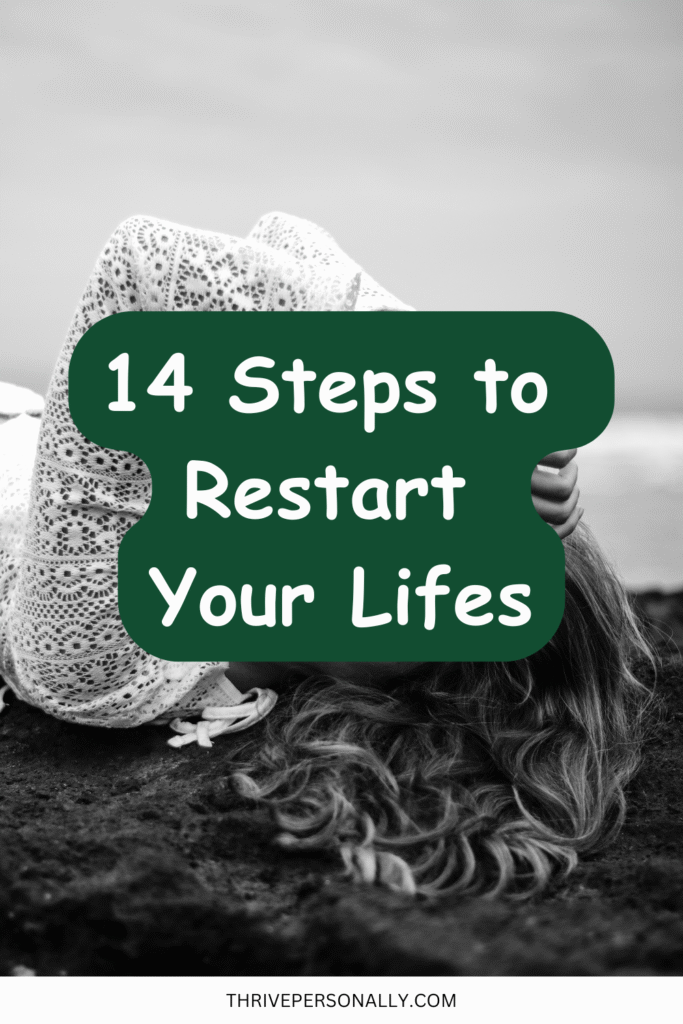One night I made a brief list of what I could do in the morning. On the first day I did something small, on the second something small again, and bit by bit the pattern grew into place. That never happened in a week. It was not error-free. But months later, the little decisions added up, and my life started to feel like it was back on track. I share that journey here so you have it as a roadmap—something you can take piece by piece, at your own pace.
This guide gives you fourteen steps in very clear terms to reclaim your life. Every step explains why it matters and how you can start today. The language is intentionally simple. You do not need big plans or perfect timing. You need only small consistent actions and the ability to come back when things go off track. Read through, choose what fits, and begin.
14 Steps to Restart Your Life
Step 1 — Name 3 Real Priorities
Pick three to five areas of life that matter to you right now. Keep it short. Naming what matters clears away noise and makes choices easier. Write your priorities on separate lines, and beside each one, note a small action you can take this week. The goal is not a long catalog of ideals, but a quick guide you can return to when life gets noisy. If you feel stuck, ask yourself: what single thing would make tomorrow lighter? That answer shows you where to start.
Read also: 10 Peaceful Life Goals
Step 2 — Begin Small and Repeat
Big changes fail because they ask too much too soon. Instead, choose the smallest action you can think of and make it part of your daily routine. When you repeat the same action in the same context, it becomes easier and more automatic. Researchers studying habit formation found that most people need consistent weeks of repetition before a new behavior feels natural. Make your step so small that you have no excuse to skip it. Little wins build real change.
Read also: Stop These 10 Energy Draining Habits Now
Step 3 — Set a Morning Routine
Create a short morning routine of three simple actions: one to wake you up, one to ground you, and one to get your mind ready for the day. Repeat them in the same order for at least three weeks. The routine gives you momentum without draining your energy. If mornings are too rushed, trim it down until it fits. Momentum matters more than perfection.
Step 4 — Sleep, a Little at a Time
A good night’s sleep changes almost everything. Start with one small bedtime habit: dim screens, go to bed at the same time, or make your room cooler and darker. You don’t need a full makeover—just steady small changes that help your body know it’s time to rest. Sleep improves focus, mood, and memory, making other steps easier. Notice how you feel after a few nights and adjust slowly.
Read also: 10 Guidelines for Creating Better Sleeping Habits
Step 5 — Protect a Block of High-Energy Time
Find the time of day when you’re sharpest and reserve it for your best work. Block it on your calendar as if it were a meeting you cannot miss. Turn off notifications, close tabs, and let others know you’re unavailable. One uninterrupted block of deep work often achieves more than hours of scattered effort. Keep it consistent—same time, same place—until your mind learns to focus at that hour.
Step 6 — Move Your Body in a Sustainable Way
You don’t need intense workouts to feel better. Do something simple that you can repeat 5 or 6 days a week: a short walk, light stretching, or just moving more. The goal is consistency. Regular movement lowers stress and boosts mood. Pair the habit with something you already do so you won’t forget. If a day is too busy, do a mini-version instead of skipping. Small motion leads to more motion.
Step 7 — Clean a Small Spot Daily
Choose one small area you can clean in five to ten minutes, and keep it tidy. When one corner is clear, you feel calmer and more in control, which makes it easier to tackle other small tasks. Make it a daily habit. A little cleanliness brings surprising peace.
Step 8 — Start One Simple Money Habit
Financial stress drains energy. Begin with a small money habit that eases that burden. Automate tiny savings, review one bill a week, or track one expense. You don’t need a full overhaul. Even a small, easy-to-stick habit can lower stress and give you more control.
Step 9 — Reset Weekly
Set aside one time each week to reset. Use it to review what went well, clear small clutter, and sketch a simple plan for the coming week. Keep it under an hour. This rhythm prevents small problems from piling up. Keep the session practical: clean, organize, plan, and rest.
Step 10 — Say No to Protect What Matters
Learn to protect your time. Say no politely but firmly, without long explanations. Saying no is not unkind—it helps you keep your promises to yourself. Start small this week by refusing one request, and watch how it opens space in your life.
Step 11 — Break a Skill into Small Steps
When learning something new, break it into the smallest possible steps and practice a little every day. Short, daily practice builds real skill faster than rare, long sessions. Track your small progress so you can see how you grow over time.
Step 12 — Find Support
Ask a close friend to know your goal and do a quick check-in with you. A text, call, or short chat can help you stay on track, especially when motivation dips. Choose someone who listens and understands that you want change. Personal accountability is often more powerful than public promises.
Step 13 — Track One Thing Simply
Focus on one habit or measure and track it simply. Use a check mark, a short note, or a single line in a notebook. Tracking is about awareness, not blame. If you miss a day, note why without judgment. Tracking patterns gives insight and encourages better choices.
Step 14 — Expect Setbacks and Plan to Restart
Slip-ups will happen. Decide ahead of time how you’ll respond. Write a quick note: what went wrong and what small action you’ll take tomorrow. Restart fast—the quicker you return, the smaller the setback. Use failures as feedback, not as proof that you failed. Restarting is one of the strongest skills you can build.
How to Apply These Steps Without Burning Out
Don’t try all fourteen steps at once. Pick three that match your current needs and focus on them for the first month. Make them so small that you cannot excuse skipping. Use your weekly reset to add one new step at a time. Change is steady and gradual; habits become automatic only through repetition in the same context.
When a Step Feels Too Hard
If you keep failing, make the step even smaller. If better sleep feels impossible, start with one change: darker room, quieter bed, or a shorter screen curfew. If your work block gets interrupted, shorten it but still protect it. When motivation fades, return to the first small step that started the change. Tiny steps let you restart sooner.
Save the pin for later



